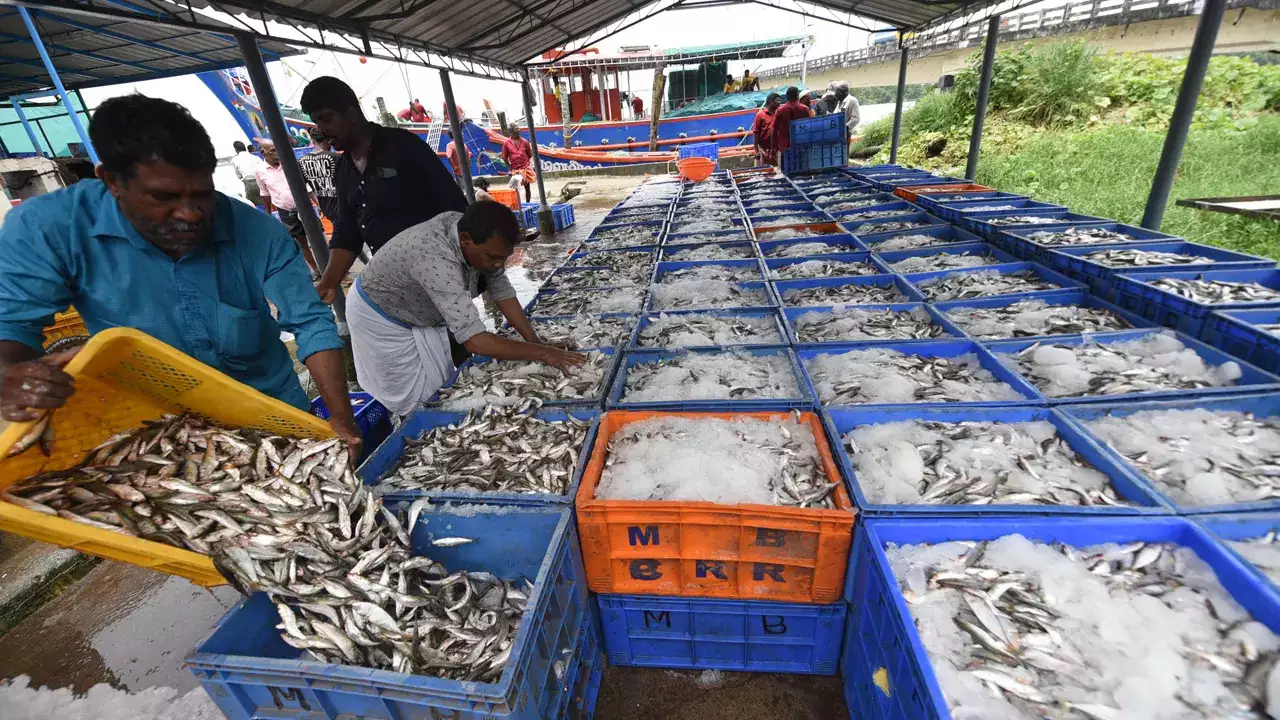India’s Fisheries Sector Receives Historic Budget Boost

The Union Budget for the fiscal year 2025-2026, presented in the Lok Sabha, marks a significant milestone for India’s fisheries sector. The government has proposed an unprecedented total budgetary support of ₹2,703.67 crores, reflecting a 3.3% increase from the previous year’s allocation of ₹2,616.44 crores. This budget aims to enhance financial inclusion and reduce the financial burden on farmers while promoting the development of marine fisheries. Union Finance Minister Smt. Nirmala Sitharaman emphasized India’s position as a leader in aquaculture and seafood exports during her budget speech. The focus on sustainable practices and the untapped potential of marine resources highlights the government’s commitment to the growth of this vital sector.
Increased Allocation for Fisheries Development
The budget for 2025-26 includes a substantial allocation of ₹2,465 crores for the Pradhan Mantri Matsya Sampada Yojana, which represents a 4.8% increase from the previous year’s allocation of ₹2,352 crores. This scheme is crucial for the development of the fisheries sector, aiming to enhance productivity and sustainability. The government plans to create a robust framework for harnessing fisheries from the Exclusive Economic Zone (EEZ) and the High Seas, with a particular focus on the Andaman and Nicobar Islands and Lakshadweep.
India boasts an EEZ of 20 lakh square kilometers and a coastline of 8,118 kilometers, with an estimated marine potential of 53 lakh tonnes. Approximately 50 lakh people rely on the marine fisheries sector for their livelihoods. The budget aims to promote deep-sea fishing and support the acquisition of resource-specific fishing vessels. This initiative is expected to unlock the potential for high-value tuna and similar species, particularly around the Andaman and Nicobar Islands and Lakshadweep. By investing in these areas, the government seeks to enhance the overall productivity and sustainability of the fisheries sector.
Empowering Coastal Communities
The development of fisheries in the Andaman and Nicobar Islands is a key focus of the budget. The EEZ area of these islands spans 6.60 lakh square kilometers, with a marine fisheries potential of 1.48 lakh tonnes, including 60,000 tonnes specifically for tuna fisheries. The government has notified the development of a Tuna Cluster, which includes establishing on-board processing and freezing facilities in tuna fishing vessels. Additionally, the Andaman and Nicobar Administration will streamline licensing for deep-sea tuna fishing vessels and provide single-window clearances.
Similarly, the Lakshadweep Islands will target its EEZ area of 4 lakh square kilometers and lagoon area of 4,200 square meters, with a potential of 1 lakh tonnes, including 4,200 tonnes for tuna fisheries. The government plans to develop a Seaweed Cluster and implement an area allocation and leasing policy. This initiative aims to empower local communities, particularly women, through the formation of Self Help Groups (SHGs) and capacity-building programs in collaboration with private entrepreneurs. By focusing on sustainable practices, the government aims to improve the livelihoods of coastal communities and promote economic stability.
Enhancing Financial Accessibility for Fishers
In a significant move to enhance credit accessibility, the government has increased the Kisan Credit Card (KCC) lending limit from ₹3 lakh to ₹5 lakh. This change aims to streamline the flow of financial resources to fishers, farmers, processors, and other stakeholders in the fisheries sector. By ensuring that necessary funds are readily available, the government hopes to support the working capital requirements of the sector.
The enhanced credit availability will facilitate the adoption of modern farming techniques, ultimately strengthening rural development and economic stability. This initiative aligns with the government’s commitment to making institutional credit more inclusive and accessible. By providing financial support, the government aims to empower stakeholders in the fisheries sector, enabling them to invest in sustainable practices and improve their overall productivity.
Boosting Competitiveness in the Global Seafood Market
To enhance India’s competitiveness in the global seafood market, the budget proposes a reduction in Basic Custom Duty (BCD) on frozen fish paste (surimi) from 30% to 5%. This reduction will facilitate the manufacturing and export of value-added seafood products, such as imitation crab meat sticks and shrimp analogues. Additionally, the government announced a reduction in import duty from 15% to 5% on fish hydrolysate, a crucial input for aquafeed manufacturing.
These measures are expected to lower production costs and increase revenue for farmers, ultimately boosting exports. The Indian fisheries sector has already established itself as a global leader, ranking second in fish production and aquaculture. With a total export value of ₹60,524 crores in 2023-24, the sector provides sustainable livelihoods to over 30 million people, particularly within marginalized communities. The government’s focus on enhancing the fisheries sector is a crucial step toward achieving its vision of a developed India by 2047.
Observer Voice is the one stop site for National, International news, Sports, Editor’s Choice, Art/culture contents, Quotes and much more. We also cover historical contents. Historical contents includes World History, Indian History, and what happened today. The website also covers Entertainment across the India and World.

